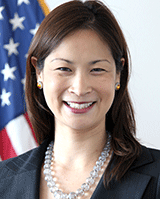OFPP’s acquisition workforce modernization effort to kick into gear in 2024
Christine Harada, the senior advisor in the Office of Federal Procurement Policy, said more than 700 contracting officers have taken the new certification process...
The Office of Federal Procurement Policy turns 50 years old in 2024.
While the federal acquisition community has come a long way since 1974, the next few years, let alone the next 50 years, will be all about the acquisition workforce.
Christine Harada, the senior advisor in OFPP, said the Biden administration’s acquisition workforce priorities for 2024 and beyond start with ensuring agencies have the appropriate people who are trained and supported, and who have the necessary skillsets for today, tomorrow and the long-term.

“We’re working to build our best inspired, engaged acquisition workforce. That, of course, requires an environment that attracts new talent and offers modern training and development opportunities, where the acquisition workforce members actually build communities both inside and across federal agencies through networking and other learning opportunities,” Harada said in an interview with Federal News Network. “The new certification process of the Federal Acquisition Certification in Contracting (FAC-C) is truly transformative because it establishes a common set of technical and professional competencies for both the Defense Department and the civilian agencies. We’re finally going to have parity with the DoD contracting professional certification, and that’ll help facilitate mobility between DoD civilian agencies in industry.”
OFPP updated the federal contracting officer training requirements in January 2023 with the goal of solving two big problems: bringing all contracting officers under one training program, and creating a standardized, independently administered assessment of contracting professionals’ competencies, which validates their initial readiness.
DoD made the reciprocity official in October in a memo and memorandum of understanding with OFPP.
“FAC-C (Professional) and the DoD Contracting Professional Certification are now aligned with a common set of certification standards that include education, training, certification exam and experience,” the memo stated. “Based on the signed MOU, I approve all DoD components and [Directors of Acquisition Career Management/Directors of Acquisition Talent Management (DACMs/DATMs)] to immediately implement the MOU and accept FAC-C (Professional) certifications as equivalent to the DoD Contracting Professional Certification. This includes current DoD employees with legacy FAC-C certifications at levels 1-3 that may not have been transitioned to the FAC-C (Professional) certification.”
Harada said early feedback on the FAC-C update has been, as expected, mostly positive. She said more than 700 people have gone through the training and expects more to take the courses in 2024.
“Everyone who’s had the legacy contracting certification was automatically given the new certification so that the new classes and exam targets folks that are newer to the government or are new to the contracting career field,” she said. “Of course, once folks have the certification, they can get training at the time of need, as it’s much more of a just-in-time training kind of a model. They’re able to chart their own career path, all in conjunction, of course, with the supervisors. Our folks can already also take many of the DoD credentials as well.”
Innovation-friendly acquisition
The training of the workforce is a key piece, but not the only challenge OFPP is trying to address. The current makeup of the acquisition workforce leans heavily toward more experienced workers who are closer to retirement.
At the General Services Administration, for example, there are four times as many people over 60 than under 30 in the Federal Acquisition Service. In fact, FAS says only about 7% of all contracting officers are under 30 years old.
Harada said while she doesn’t believe the situation is as dire as it was earlier in the 2010s, more needs to be done to bring in the next generation. The number of 1102s, or contracting officers, is at its highest point in the last 10 years, and possibly since before those cuts in the late 1980s and early 1990s.
“I’m also really excited by the advances that are being made to create a much more innovation-friendly acquisition environment, with a number of innovation labs and safe spaces, a robust knowledge management portal with the periodic table of acquisition innovations,” she said. “I do think that demographically speaking, the more junior or the newer contracting folks who tend to be a little bit more technology savvy are much more embracing of these types of efforts. I can’t overstate the potential here: If you look at the periodic table of acquisition innovation, you’ll see all sorts of examples of how our buyers are reducing bid proposal costs, shortening the time for proposal submission to award, and efforts to promote that innovative mindset that values creative thinking outcomes and risk management over just a rigid compliance kind of framework. That is really contributing to that greater sense of empowerment problem solve within the acquisition workforce.”
Outside of the federal acquisition workforce, Harada said OFPP’s other 2024 priorities are further strengthening and diversifying the supplier base and improving the underlying data that supports the acquisition workforce and contracting processes.
All of these efforts fall under the Biden administration’s new Better Contracting Initiative, which it kicked off in November. The goal is to give agencies better data and better tools to extract more value from acquisitions. As part of this effort, OFPP proposed a new circular in November, which would establish a new acquisition data management policy that would require agencies to create policies, processes and tools for acquisition data sharing.
Comments on the draft circular are due Jan. 16.
Small business, category management
Harada said a key piece to the Better Contracting Initiative is continuing the evolution of category management. Part of that effort means improving the management of software purchasing. OFPP is revamping its goal of creating enterprisewide software licenses or developing requirements for professional services contracts right the first time or reducing risks in sole source or other similar types of contracts.
“It absolutely remains a signature initiative for us in that those policies and practices have really shaped and helped the government buy as a much more organized entity. That lies very much at the heart of our ability to be able to meet our country’s demands within today’s constrained budget environment,” she said. “By moving away from the model where everybody fended for themselves to a much more enterprisewide approach, we’ve been able to avoid upwards of $90 billion in costs for taxpayers since 2016.”
That means OFPP and its partners like GSA are looking for new, innovative approaches to “bake” these concepts into agency acquisition processes.
Harada said the “baking” and innovation has to put small businesses front and center. She said based on initial data, agencies surpassed the 23% goal for small business contracting in fiscal 2023 and met or exceeded socioeconomic goals for other small business categories previous years and expected to do better in 2023.
“We’re focused not only on the dollars, but also in the breadth and depth of small business participation in the federal marketplace. In fact, I think [Office of Management and Budget Deputy Director for Management] Jason Miller put it best when he said that the record breaking number of applications to start new small businesses creates an imperative on the federal marketplace to be able to leverage that growth and supply chains. It’s important for agency missions and to reverse the decline that we’ve been seeing since 2010,” Harada said. “To help meet that challenge, we have released new guidance to strengthen management attention on new entrants, and I think what’s particularly noteworthy is that this administration also deployed two tools to assist agencies with finding and measuring new and recent entrant participation rate. We’ve got the federal supplier database and dashboard that helps agencies track their performance over time by comparing the composition of the contractor base as well as the procurement equity tool. We can ensure that we’re doing that kind of appropriate outreach, etc.”
Copyright © 2025 Federal News Network. All rights reserved. This website is not intended for users located within the European Economic Area.
Jason Miller is executive editor of Federal News Network and directs news coverage on the people, policy and programs of the federal government.
Follow @jmillerWFED






